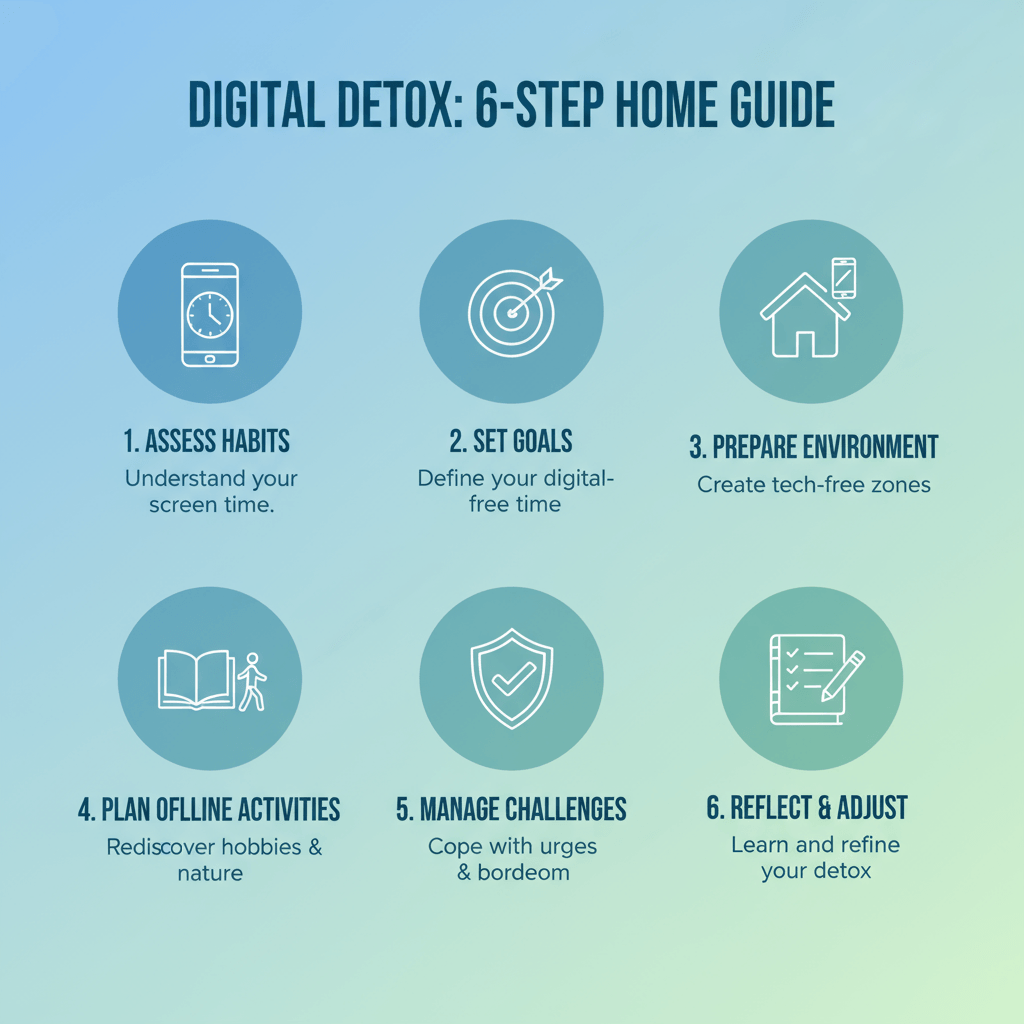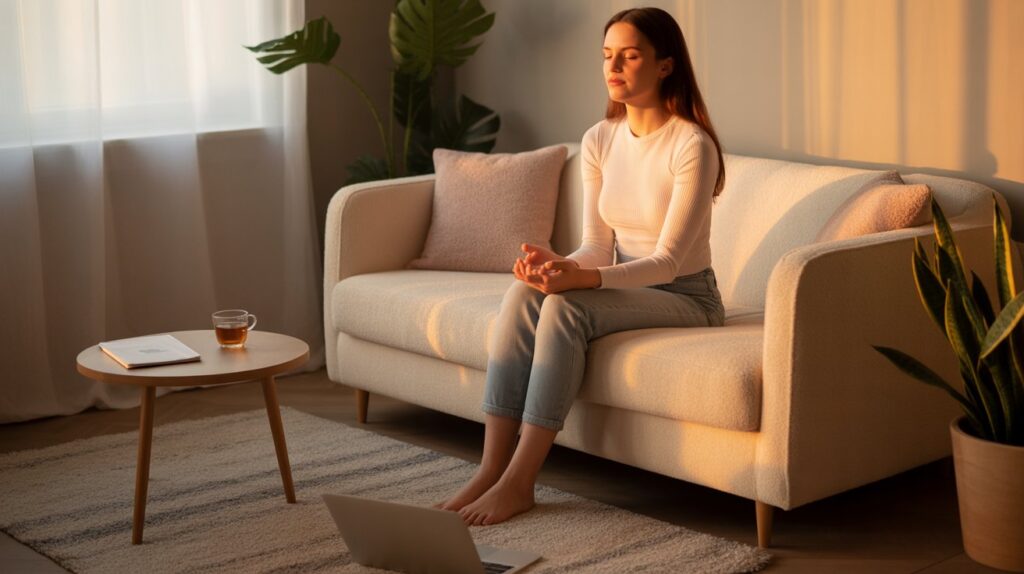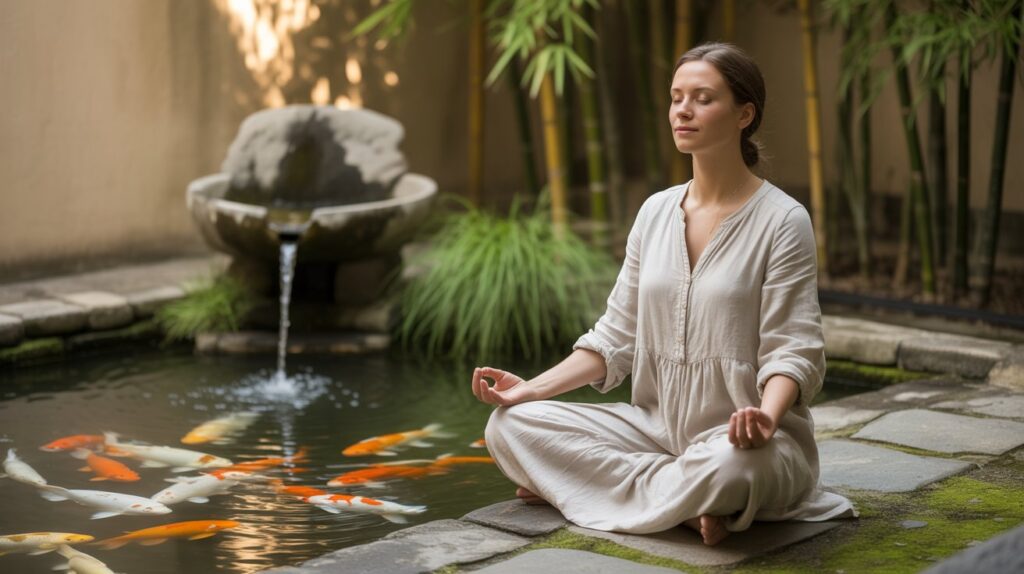Taking a break from screens doesn’t have to mean a complete tech blackout or expensive retreats. A digital detox at home can be simple, sustainable, and tailored to your lifestyle. Follow these steps to start reclaiming your focus, improving sleep, and reducing stress.
Step 1: Assess Your Digital Habits
Understanding how much time you spend on devices is the first critical step toward positive change. Being aware of your current habits helps you identify problem areas and set realistic goals.
Begin by using built-in screen time tracking features available on most smartphones:
- On iPhone: Go to Settings > Screen Time to view usage and set limits.
- On Android: Go to Settings > Digital Wellbeing & Parental Controls.
Ask yourself:
- How many hours per day do I spend on my phone, computer, or TV?
- Which apps or sites cause distraction or stress?
- How does device use affect my mood, sleep, relationships, or productivity?
Example: Sara discovered she spent over 3 hours daily on social media, mostly before bedtime, which led to poor sleep.
Step 2: Set Specific and Realistic Detox Goals
Setting clear, achievable goals increases your chances of success. Address your biggest digital pain points with measurable targets.
Examples:
- Stop screen use 1 hour before bedtime to improve sleep quality.
- Limit social media to 30 minutes daily for 2 weeks.
- Leave your phone in another room during meals or work sessions.
Write your goals down along with a timeframe and expected benefits. For example:
“Starting tomorrow, I will stop using my phone at least one hour before bed to improve sleep and reduce anxiety.”
Tip: Use apps like Freedom or Stay Focused to help monitor and limit your screen time as you work toward your goals.
Step 3: Prepare Your Environment to Support Detox
Your surroundings can either support or sabotage your detox efforts. Make it easier to stick to your goals by adjusting your environment:
- Designate device-free zones such as your bedroom and dining table to encourage presence.
- Turn off non-essential notifications or activate “Do Not Disturb” or “Focus Mode” during detox periods.
- Uninstall or log out of apps that trigger excessive use during detox hours to reduce temptation.
- Use physical reminders like printed books or journals to replace digital content.
For different lifestyles:
- Professionals might keep work phones separate from personal devices.
- Parents can implement device-free family meal zones.
- Students can create study areas free of distracting tech.
Step 4: Plan Offline Activities to Replace Screen Time
Replacing screen time with meaningful offline activities is key to preventing relapse and enjoying your detox.
Try:
- Reading a book or magazine.
- Journaling or creative writing to process thoughts and reduce stress.
- Cooking a new recipe or baking for a therapeutic break.
- Practicing yoga, meditation, or simple breathing exercises to recharge mentally.
- Going for nature walks or engaging in outdoor hobbies for fresh air and movement.
- Connecting face-to-face with family or friends to deepen relationships.
Pro tip: Schedule these activities close to your planned detox times to build positive associations.
Step 5: Manage Common Detox Challenges
Detoxing can trigger withdrawal symptoms like boredom, temptation, or “fear of missing out” (FOMO). Here’s how to stay on track:
- Use grayscale mode on your phone to make it less visually enticing.
- Employ app blockers such as Freedom or Stay Focused to limit access during detox.
- Find a digital detox buddy to share progress, offer support, and maintain accountability.
- Replace urges to scroll with short mindfulness or breathing breaks to reset.
- Remind yourself of your goals and the improvements you expect for motivation.
Handling social pressure: Explain your detox to friends and family to gain their support and set boundaries with tech use during social time.
Step 6: Reflect and Adjust Your Detox Plan
Reflection is crucial to understand what works for you and to improve future detoxes.
Keep a journal or log and note:
- What times of day were most challenging?
- Which goals felt achievable vs. too difficult?
- What offline activities did you enjoy the most?
- Did you notice improvements in sleep, mood, or focus?
Use these insights to adjust your goals, detox duration, and activities—making your digital detox practice more effective and sustainable each time.

Tiered Detox Plans: Pick What Works for You
- Mini Detox: Daily 1–2 hour breaks using device-free zones (e.g., meals or mornings)
- Weekend Detox: No personal devices from Friday evening to Sunday night, focusing on offline connection
- Extended Detox: 7-day or longer detox with planned offline activities and social accountability
Quick Detox Checklist
- Track your screen time for one week.
- Set one specific digital detox goal with a timeframe.
- Create device-free zones at home.
- Schedule at least one offline activity daily.
- Use apps or tools to block distracting content.
- Find an accountability partner.
- Journal your progress daily.
- Review and adjust your plan weekly.
Bonus Tips for a Successful Detox
- Start small and gradually increase detox durations.
- Combine detox with calming techniques like meditation or aromatherapy.
- Celebrate small wins to stay motivated.
- Don’t strive for perfection—self-compassion helps make the habit stick.
- Consider switching to ‘Dumbphone‘ or flip-phones. These basic, internet-free devices are making a comeback as people seek refuge from endless notifications and social media overload.
To deepen your understanding of how technology affects the brain and why digital detoxes are so beneficial, explore our comprehensive article on Digital Dopamine. It uncovers the neuroscience behind device addiction, dopamine reward loops, and practical strategies to retrain your brain for healthier digital habits—empowering you to build lasting balance in today’s connected world.












